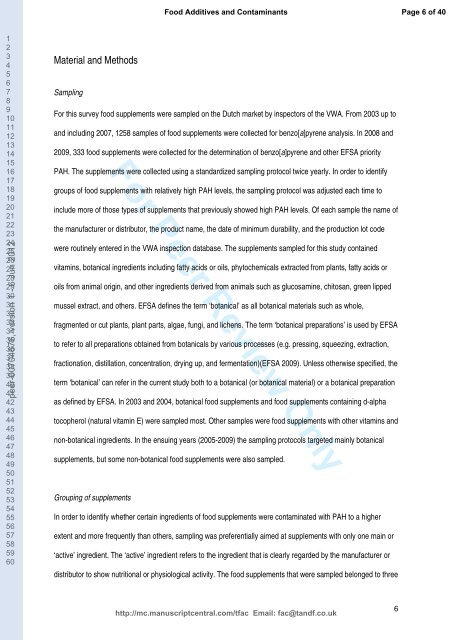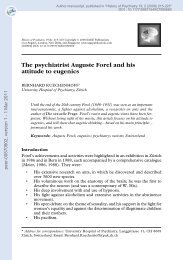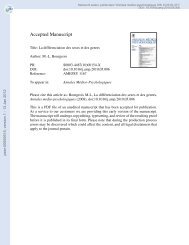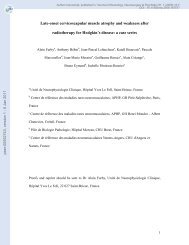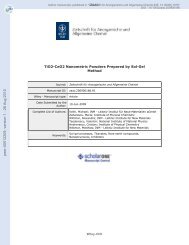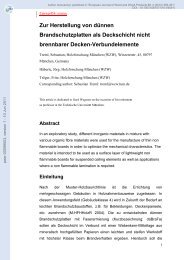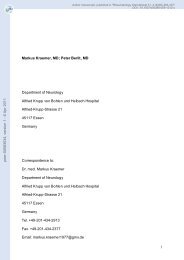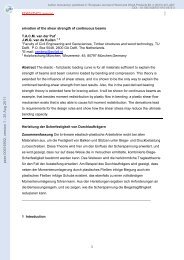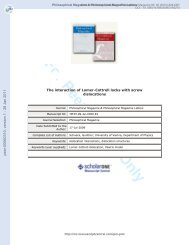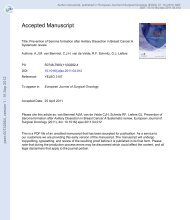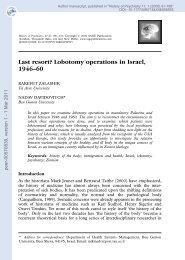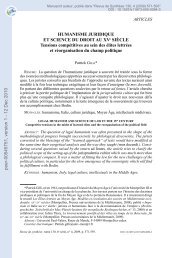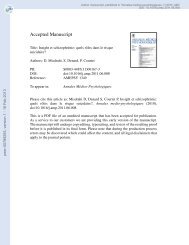Monitoring of Polycyclic Aromatic Hydrocarbons (PAH) in food ...
Monitoring of Polycyclic Aromatic Hydrocarbons (PAH) in food ...
Monitoring of Polycyclic Aromatic Hydrocarbons (PAH) in food ...
Create successful ePaper yourself
Turn your PDF publications into a flip-book with our unique Google optimized e-Paper software.
1<br />
2<br />
3<br />
4<br />
5<br />
6<br />
7<br />
8<br />
9<br />
10<br />
11<br />
12<br />
13<br />
14<br />
15<br />
16<br />
17<br />
18<br />
19<br />
20<br />
21<br />
22<br />
23<br />
24<br />
25<br />
26<br />
27<br />
28<br />
29<br />
30<br />
31<br />
32<br />
33<br />
34<br />
35<br />
36<br />
37<br />
38<br />
39<br />
40<br />
peer-00704676, version 1 - 6 Jun 2012<br />
41<br />
42<br />
43<br />
44<br />
45<br />
46<br />
47<br />
48<br />
49<br />
50<br />
51<br />
52<br />
53<br />
54<br />
55<br />
56<br />
57<br />
58<br />
59<br />
60<br />
Material and Methods<br />
Sampl<strong>in</strong>g<br />
For this survey <strong>food</strong> supplements were sampled on the Dutch market by <strong>in</strong>spectors <strong>of</strong> the VWA. From 2003 up to<br />
and <strong>in</strong>clud<strong>in</strong>g 2007, 1258 samples <strong>of</strong> <strong>food</strong> supplements were collected for benzo[a]pyrene analysis. In 2008 and<br />
2009, 333 <strong>food</strong> supplements were collected for the determ<strong>in</strong>ation <strong>of</strong> benzo[a]pyrene and other EFSA priority<br />
For Peer Review Only<br />
<strong>PAH</strong>. The supplements were collected us<strong>in</strong>g a standardized sampl<strong>in</strong>g protocol twice yearly. In order to identify<br />
groups <strong>of</strong> <strong>food</strong> supplements with relatively high <strong>PAH</strong> levels, the sampl<strong>in</strong>g protocol was adjusted each time to<br />
<strong>in</strong>clude more <strong>of</strong> those types <strong>of</strong> supplements that previously showed high <strong>PAH</strong> levels. Of each sample the name <strong>of</strong><br />
the manufacturer or distributor, the product name, the date <strong>of</strong> m<strong>in</strong>imum durability, and the production lot code<br />
were rout<strong>in</strong>ely entered <strong>in</strong> the VWA <strong>in</strong>spection database. The supplements sampled for this study conta<strong>in</strong>ed<br />
vitam<strong>in</strong>s, botanical <strong>in</strong>gredients <strong>in</strong>clud<strong>in</strong>g fatty acids or oils, phytochemicals extracted from plants, fatty acids or<br />
oils from animal orig<strong>in</strong>, and other <strong>in</strong>gredients derived from animals such as glucosam<strong>in</strong>e, chitosan, green lipped<br />
mussel extract, and others. EFSA def<strong>in</strong>es the term ‘botanical’ as all botanical materials such as whole,<br />
fragmented or cut plants, plant parts, algae, fungi, and lichens. The term ‘botanical preparations’ is used by EFSA<br />
to refer to all preparations obta<strong>in</strong>ed from botanicals by various processes (e.g. press<strong>in</strong>g, squeez<strong>in</strong>g, extraction,<br />
fractionation, distillation, concentration, dry<strong>in</strong>g up, and fermentation)(EFSA 2009). Unless otherwise specified, the<br />
term ‘botanical’ can refer <strong>in</strong> the current study both to a botanical (or botanical material) or a botanical preparation<br />
as def<strong>in</strong>ed by EFSA. In 2003 and 2004, botanical <strong>food</strong> supplements and <strong>food</strong> supplements conta<strong>in</strong><strong>in</strong>g d-alpha<br />
tocopherol (natural vitam<strong>in</strong> E) were sampled most. Other samples were <strong>food</strong> supplements with other vitam<strong>in</strong>s and<br />
non-botanical <strong>in</strong>gredients. In the ensu<strong>in</strong>g years (2005-2009) the sampl<strong>in</strong>g protocols targeted ma<strong>in</strong>ly botanical<br />
supplements, but some non-botanical <strong>food</strong> supplements were also sampled.<br />
Group<strong>in</strong>g <strong>of</strong> supplements<br />
Food Additives and Contam<strong>in</strong>ants<br />
In order to identify whether certa<strong>in</strong> <strong>in</strong>gredients <strong>of</strong> <strong>food</strong> supplements were contam<strong>in</strong>ated with <strong>PAH</strong> to a higher<br />
extent and more frequently than others, sampl<strong>in</strong>g was preferentially aimed at supplements with only one ma<strong>in</strong> or<br />
‘active’ <strong>in</strong>gredient. The ‘active’ <strong>in</strong>gredient refers to the <strong>in</strong>gredient that is clearly regarded by the manufacturer or<br />
distributor to show nutritional or physiological activity. The <strong>food</strong> supplements that were sampled belonged to three<br />
http://mc.manuscriptcentral.com/tfac Email: fac@tandf.co.uk<br />
6<br />
Page 6 <strong>of</strong> 40


